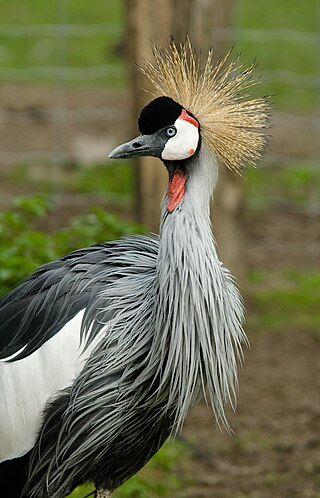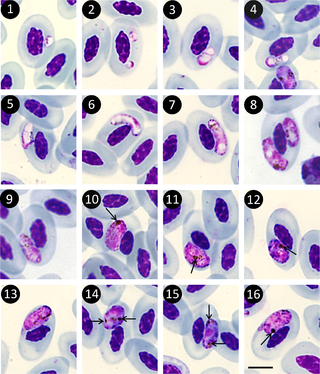
Equidae is the taxonomic family of horses and related animals, including the extant horses, asses, and zebras, and many other species known only from fossils. The family evolved around 50 million years ago from a small, multi-toed ungulate into larger, single-toed animals. All extant species are in the genus Equus, which originated in North America. Equidae belongs to the order Perissodactyla, which includes the extant tapirs and rhinoceros, and several extinct families. It is more specifically grouped within the superfamily Equoidea, the only other family being the extinct Palaeotheriidae.

The Percolozoa are a group of colourless, non-photosynthetic Excavata, including many that can transform between amoeboid, flagellate, and cyst stages.

Genus is a taxonomic rank above species and below family as used in the biological classification of living and fossil organisms as well as viruses. In binomial nomenclature, the genus name forms the first part of the binomial species name for each species within the genus.

Nightjars are medium-sized nocturnal or crepuscular birds in the family Caprimulgidae and order Caprimulgiformes, characterised by long wings, short legs, and very short bills. They are sometimes called bugeaters, their primary source of food being insects. Some New World species are called nighthawks. The English word nightjar originally referred to the European nightjar.

The lagomorphs are the members of the taxonomic order Lagomorpha, of which there are two living families: the Leporidae and the Ochotonidae (pikas). There are 110 recent species of lagomorph of which 109 are extant, including ten genera of rabbits, one genus of hare and one genus of pika. The name of the order is derived from the Ancient Greek lagos + morphē.

The Rutaceae is a family, commonly known as the rue or citrus family, of flowering plants, usually placed in the order Sapindales.

The International Code of Zoological Nomenclature (ICZN) is a widely accepted convention in zoology that rules the formal scientific naming of organisms treated as animals. It is also informally known as the ICZN Code, for its publisher, the International Commission on Zoological Nomenclature. The rules principally regulate:

The bulbuls are members of a family, Pycnonotidae, of medium-sized passerine songbirds, which also includes greenbuls, brownbuls, leafloves, and bristlebills. The family is distributed across most of Africa and into the Middle East, tropical Asia to Indonesia, and north as far as Japan. A few insular species occur on the tropical islands of the Indian Ocean. There are 166 species in 32 genera. While different species are found in a wide range of habitats, the African species are predominantly found in rainforest, whereas Asian bulbuls are predominantly found in more open areas.

The Gruiformes are an order containing a considerable number of living and extinct bird families, with a widespread geographical diversity. Gruiform means "crane-like".

Anseriformes is an order of birds also known as waterfowl that comprises about 180 living species of birds in three families: Anhimidae, Anseranatidae, and Anatidae, the largest family, which includes over 170 species of waterfowl, among them the ducks, geese, and swans. Most modern species in the order are highly adapted for an aquatic existence at the water surface. With the exception of screamers, males have penises, a trait that has been lost in the Neoaves, the clade consisting of all other modern birds except the landfowl sister order and the paleognath infraclass. Due to their aquatic nature, most species are web-footed.

Laridae is a family of seabirds in the order Charadriiformes that includes the gulls, terns, noddies, skimmers, and white terns. It includes around 100 species arranged into 22 genera. They are an adaptable group of mostly aerial birds found worldwide.

Herons are long-legged, long-necked, freshwater and coastal birds in the family Ardeidae, with 74 recognised species, some of which are referred to as egrets or bitterns rather than herons. Members of the genus Botaurus are referred to as bitterns, and, together with the zigzag heron, or zigzag bittern, in the monotypic genus Zebrilus, form a monophyletic group within the Ardeidae. Egrets do not form a biologically distinct group from herons, and tend to be named differently because they are mainly white or have decorative plumes in breeding plumage. Herons, by evolutionary adaptation, have long beaks.

Old World monkeys are primates in the family Cercopithecidae. Twenty-four genera and 138 species are recognized, making it the largest primate family. Old World monkey genera include baboons, red colobus, and macaques. Common names for other Old World monkeys include the talapoin, guenon, colobus, douc, vervet, gelada, mangabey, langur, mandrill, drill, surili (Presbytis), patas, and proboscis monkey.
In biology, a monotypic taxon is a taxonomic group (taxon) that contains only one immediately subordinate taxon. A monotypic species is one that does not include subspecies or smaller, infraspecific taxa. In the case of genera, the term "unispecific" or "monospecific" is sometimes preferred. In botanical nomenclature, a monotypic genus is a genus in the special case where a genus and a single species are simultaneously described.

A botanical name is a formal scientific name conforming to the International Code of Nomenclature for algae, fungi, and plants (ICN) and, if it concerns a plant cultigen, the additional cultivar or Group epithets must conform to the International Code of Nomenclature for Cultivated Plants (ICNCP). The code of nomenclature covers "all organisms traditionally treated as algae, fungi, or plants, whether fossil or non-fossil, including blue-green algae (Cyanobacteria), chytrids, oomycetes, slime moulds and photosynthetic protists with their taxonomically related non-photosynthetic groups ."

The Plasmodiidae are a family of apicomplexan parasites, including the type genus Plasmodium, which is responsible for malaria. This family was erected in 1903 by Mesnil and is one of the four families in the order Haemospororida.

Trionychia is a superfamily of turtles which encompasses the species that are commonly referred to as softshelled turtles as well as some others. The group contains two families, Carettochelyidae, which has only one living species, the pig-nosed turtle native to New Guinea and Northern Australia, and Trionychidae, the softshelled turtles, containing numerous species native to Asia, North America and Africa. These families likely diverged during the late Jurassic. The oldest known stem-trionychian is Sinaspideretes from the Late Jurassic of China.

Feliformia is a suborder within the order Carnivora consisting of "cat-like" carnivorans, including cats, hyenas, mongooses, viverrids, and related taxa. Feliformia stands in contrast to the other suborder of Carnivora, Caniformia.

The Haemosporida are an order of intraerythrocytic parasitic alveolates.

Cydippida is an order of comb jellies. They are distinguished from other comb jellies by their spherical or oval bodies, and the fact their tentacles are branched, and can be retracted into pouches on either side of the pharynx. The order is not monophyletic, that is, more than one common ancestor is believed to exist.


















